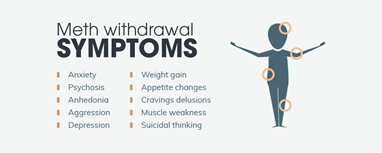Methamphetamine presents as small bluish and whitish rocks or as small pieces of glass, and is highly addictive. It is known by a number of street names including glass, ice, crank, shards, etc. The drug is typically snorted or smoked.
Withdrawal from crystal meth is most likely not potentially physically damaging unless the individual becomes extremely emotionally unstable and engages in self-harm.
Methamphetamine has a relatively short half-life (an average around 10 hours), and it is a fast-acting drug. In general, according to research, it appears that the timeline for withdrawal from crystal meth is fairly consistent among users:
- It begins within the first 24 hours of abstinence.
- It reaches its peak within the first 7-10 days following discontinuation of the drug, and there is a steady decline in the intensity of symptoms following this peak.
- It has an average duration of about 14-20 days, with 14 days being the most commonly reported duration of the withdrawal syndrome.
Meth comedown symptoms include:
- Hopelessness
- Sadness
- Depression
- Muscle weakness
- Decreased appetite
- Fatigue
- Lack of motivation
- Anxiety
- Insomnia despite exhaustion
- Headache from dehydration
- Muscle pain, especially in the jaw from clenching
Comedown symptoms may last for a few days after one abuses the drug, especially mental health changes like depression and anxiety. When abused as a party drug, meth may be mixed with other amphetamines, opioids, or alcohol. Mixing drugs together is very dangerous and can cause an overdose; in addition, comedown symptoms will feel worse or more intense when substances are combined. If the individual does not take any more meth, these symptoms will resolve on their own.
It is important to understand the symptoms of a comedown from stimulant drugs like meth because many people who begin to abuse these drugs take more as the comedown symptoms begin to set in. This leads to binges, which can cause a deadly overdose or long-term harm to the brain and body.
Meth binges are called “tweaking.” Too often, to avoid the depression and physical weakness associated with a meth comedown, someone abusing the drug will take more, which increases the intensity of effects and side effects. This, in turn, increases the intensity of depression symptoms when the drug begins to wear off, leading the individual to take more meth..
Source: https://americanaddictioncenters.org/meth-treatment/withdrawal



Bài viết liên quan: